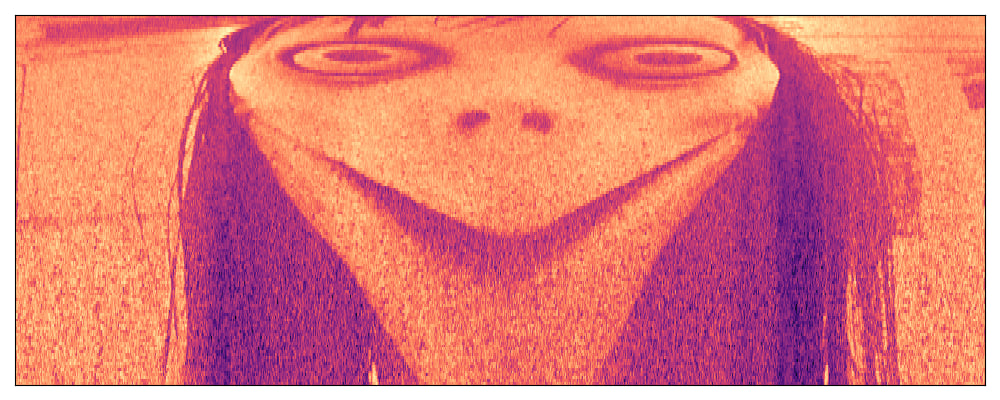import numpy as np
import matplotlib.pyplot as plt
from PIL import Image, ImageDraw, ImageFont
import librosa
import librosa.display
import gradio as gr
import soundfile as sf
import os
import gettext
import os
font_path = "/usr/share/fonts/truetype/dejavu/DejaVuSans-Bold.ttf"
if not os.path.exists(font_path):
font_path = "/usr/share/fonts/truetype/liberation/LiberationSans-Bold.ttf" # Fallback font
# Handle missing translation files
locales_dir = 'locales'
try:
lang = gettext.translation('base', localedir=locales_dir, languages=['id'])
lang.install()
_ = lang.gettext
except FileNotFoundError:
print("Translation file not found, using default language.")
_ = lambda s: s # Fallback to the original string if translation is unavailable
# Function for creating a spectrogram image with text
def text_to_spectrogram_image(text, base_width=512, height=256, max_font_size=80, margin=10, letter_spacing=5):
font_path = "/usr/share/fonts/truetype/dejavu/DejaVuSans-Bold.ttf"
if os.path.exists(font_path):
font = ImageFont.truetype(font_path, max_font_size)
else:
font = ImageFont.load_default()
image = Image.new('L', (base_width, height), 'black')
draw = ImageDraw.Draw(image)
text_width = 0
for char in text:
text_bbox = draw.textbbox((0, 0), char, font=font)
text_width += text_bbox[2] - text_bbox[0] + letter_spacing
text_width -= letter_spacing
if text_width + margin * 2 > base_width:
width = text_width + margin * 2
else:
width = base_width
image = Image.new('L', (width, height), 'black')
draw = ImageDraw.Draw(image)
text_x = (width - text_width) // 2
text_y = (height - (text_bbox[3] - text_bbox[1])) // 2
for char in text:
draw.text((text_x, text_y), char, font=font, fill='white')
char_bbox = draw.textbbox((0, 0), char, font=font)
text_x += char_bbox[2] - char_bbox[0] + letter_spacing
image = np.array(image)
image = np.where(image > 0, 255, image)
return image
# Converting an image to audio
def spectrogram_image_to_audio(image, sr=22050):
flipped_image = np.flipud(image)
S = flipped_image.astype(np.float32) / 255.0 * 100.0
y = librosa.griffinlim(S)
return y
# Function for creating an audio file and spectrogram from text
def create_audio_with_spectrogram(text, base_width, height, max_font_size, margin, letter_spacing):
spec_image = text_to_spectrogram_image(text, base_width, height, max_font_size, margin, letter_spacing)
y = spectrogram_image_to_audio(spec_image)
audio_path = 'output.wav'
sf.write(audio_path, y, 22050)
image_path = 'spectrogram.png'
plt.imsave(image_path, spec_image, cmap='gray')
return audio_path, image_path
# Function for displaying the spectrogram of an audio file
def display_audio_spectrogram(audio_path):
y, sr = librosa.load(audio_path)
S = librosa.feature.melspectrogram(y=y, sr=sr)
S_dB = librosa.power_to_db(S, ref=np.max)
plt.figure(figsize=(10, 4))
librosa.display.specshow(S_dB)
plt.tight_layout()
spectrogram_path = 'uploaded_spectrogram.png'
plt.savefig(spectrogram_path)
plt.close()
return spectrogram_path
# Converting a downloaded image to an audio spectrogram
def image_to_spectrogram_audio(image_path, sr=22050):
image = Image.open(image_path).convert('L')
image = np.array(image)
y = spectrogram_image_to_audio(image, sr)
img2audio_path = 'image_to_audio_output.wav'
sf.write(img2audio_path, y, sr)
return img2audio_path
informstion = _("""
Steganography Information
Ha-Ha-Ha, I'm laughing at you.
People, before using this interface, read about what Steganography is.
What is STEGANOGRAPHY?
Steganography is a method of hiding information within other information or a physical object in such a way
that it cannot be detected. Using steganography, you can hide almost any digital content, including texts,
images, audio, and video files.
In this interface, steganography is used to hide text or an image in the spectrogram of a sound.

 """)
# Gradio interface
with gr.Blocks(
title=_('Audio Steganography'),
theme="Hev832/Applio",
) as iface:
gr.Markdown(_("# Audio Steganography"))
with gr.Group():
with gr.Row(variant='panel'):
with gr.Column():
gr.HTML(_(""))
with gr.Column():
gr.HTML(_(""))
with gr.Column():
gr.HTML(_(""))
with gr.Column():
gr.HTML(_(""))
with gr.Tab(_("INFO")):
gr.HTML(informstion)
with gr.Tab(_("Text to Spectrogram")):
gr.HTML(_("
""")
# Gradio interface
with gr.Blocks(
title=_('Audio Steganography'),
theme="Hev832/Applio",
) as iface:
gr.Markdown(_("# Audio Steganography"))
with gr.Group():
with gr.Row(variant='panel'):
with gr.Column():
gr.HTML(_(""))
with gr.Column():
gr.HTML(_(""))
with gr.Column():
gr.HTML(_(""))
with gr.Column():
gr.HTML(_(""))
with gr.Tab(_("INFO")):
gr.HTML(informstion)
with gr.Tab(_("Text to Spectrogram")):
gr.HTML(_("Oh my god people, learn to read. Go to the “INFO” tab, it says what this interface is and what it is for, don't be idiots.
"))
with gr.Group():
text = gr.Textbox(lines=2, placeholder=_("Enter your text:"), label=_("Text"))
with gr.Row(variant='panel'):
base_width = gr.Slider(value=512, label=_("Image Width"), visible=False)
height = gr.Slider(value=256, label=_("Image Height"), visible=False)
max_font_size = gr.Slider(minimum=10, maximum=130, step=5, value=80, label=_("Font size"))
margin = gr.Slider(minimum=0, maximum=50, step=1, value=10, label=_("Indent"))
letter_spacing = gr.Slider(minimum=0, maximum=50, step=1, value=5, label=_("Letter spacing"))
generate_button = gr.Button(_("Generate"))
with gr.Column(variant='panel'):
with gr.Group():
output_audio = gr.Audio(type="filepath", label=_("Generated audio"))
output_image = gr.Image(type="filepath", label=_("Spectrogram"))
def gradio_interface_fn(text, base_width, height, max_font_size, margin, letter_spacing):
print("\n", text)
return create_audio_with_spectrogram(text, base_width, height, max_font_size, margin, letter_spacing)
generate_button.click(
gradio_interface_fn,
inputs=[text, base_width, height, max_font_size, margin, letter_spacing],
outputs=[output_audio, output_image]
)
with gr.Tab(_("Image to Spectrogram")):
gr.HTML(_("Oh my god people, learn to read. Go to the “INFO” tab, it says what this interface is and what it is for, don't be idiots.
"))
with gr.Group():
with gr.Row(variant='panel'):
upload_image = gr.Image(type="filepath", label=_("Upload image"))
convert_button = gr.Button(_("Convert to audio"))
with gr.Column(variant='panel'):
output_audio_from_image = gr.Audio(type="filepath", label=_("Generated audio"))
def gradio_image_to_audio_fn(upload_image):
return image_to_spectrogram_audio(upload_image)
convert_button.click(
gradio_image_to_audio_fn,
inputs=[upload_image],
outputs=[output_audio_from_image]
)
with gr.Tab(_("Audio Spectrogram")):
with gr.Group():
with gr.Row(variant='panel'):
upload_audio = gr.Audio(type="filepath", label=_("Upload audio"), scale=3)
decode_button = gr.Button(_("Show spectrogram"), scale=2)
with gr.Column(variant='panel'):
decoded_image = gr.Image(type="filepath", label=_("Audio Spectrogram"))
def gradio_decode_fn(upload_audio):
return display_audio_spectrogram(upload_audio)
decode_button.click(
gradio_decode_fn,
inputs=[upload_audio],
outputs=[decoded_image]
)
iface.launch(share=True, debug=True)